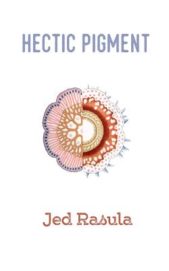 Jed Rasula
Jed Rasula
Opo Books & Objects ($15)
by James Cook
Known primarily for his scholarly criticism of European Modernism and the New American poets, Jed Rasula has also quietly published two previous books of his own poetry. His third, Hectic Pigment, is a short (54 pages), pocket-sized, sharply sculpted volume of six poems that shows the influence of the Dada and Surrealist precursors he’s written about so lucidly.
Hectic Pigment is bookended by two ekphrastic pieces. The first (and longest) “Giacometti’s Dog,” weaves a series of absurdist narratives and stark imagery around aspects of Giacometti’s art and life. Throughout the poem, Rasula’s images reflect the eroding, skeletal lines of Giacometti’s sculpture:
advancing and recoiling at once
she pins you to fadingshe’s almost sexy
except she’s a skeletonher scribble of hips
will whittle youinto a pencil
she will write withuntil you are blunt
with extraction
At times one is reminded of the phenomenological/philosophical lyric-narratives of fellow Olsonian Charles Stein, except in Rasula’s book, a series of gestures might terminate without any clear metaphysical underpinnings, just the dance of language reflecting the dance of matter in its swirling and hallucinatory organized chaos. Take “The Pomps of the Subsoils,” which appears to be a meditation on the act of artistic creation itself. Here the poet utilizes the versatile and wiry long line that is a signature of his, able to accommodate a projective language full of particulars, a disjunctive visionary lyricism:
An atonal logic at midnight, no longer a thread
unraveled through a maze,
but a simple straight line, bewitching enigma,
this siphon.
Throughout Hectic Pigment, the author seeks to present a world in which matter is constantly transforming, often violently, through the creative act. It’s a stance reflected in the hybrid forms of Rasula’s art: jagged, fragmented, spare lines overlap a supple biographical prose, which in turn becomes a nightmarish fever-dream followed by a quotation. One of Rasula’s most important books of criticism, This Compost: Ecological Imperatives in American Poetry (University of Georgia Press, 2002), charts a poetics of renewal and palimpsest, a patchwork in which the fertile field of past literatures posits a constantly evolving present. This idea deeply informs Hectic Pigment, as Rasula examines the nature of art, the cycles of birth and death, the inevitable failure of language to communicate the essential, and the beautiful broken forms which are the result of the effort:
there’s a mountain of pacing about
that wears a trench of you
down to sprung plush
gulp on gulpthere’s also a mountain
of meaningless Hercules
where dowel pins owl
hour by horrible hour
The final poem in the volume, “Pollock’s Hectic Pigment,” is an examination and response to the work of the famed action painter, and the poem alone is worth the price of the book. Again utilizing an elastic long line, Rasula is a demented museum guide, giving us a whirlwind tour through the dark, magical forms which underlie Jackson Pollock’s work, secret shapes just beneath the seemingly random surfaces of the dripped and splattered paint:
Now we come into the country we know–
spider arabesque. Grim tutorials of chance
subsiding in a spellbound squeal,
Queequeg’s casket itching with hieroglyphs
inside and out till it’s all inside-out. A tattoo
of dunk. Eye chowder. Shudder and chatter.
What is embellishment now? He’s clipped a
figure from a different blur and pasted it
over the stars until there’s a snout of
dangling silhouettes, almost a waddle that
wants to say it can’t dance. But does.
So too this book.
